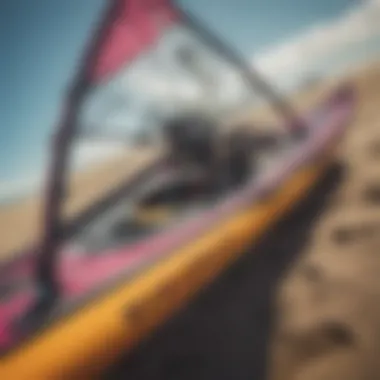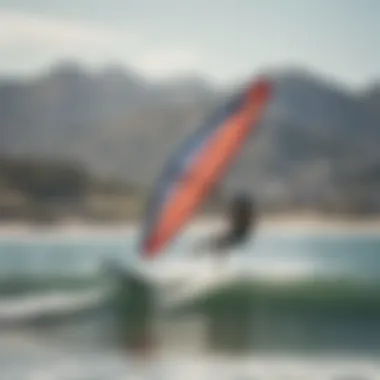Kite Surfing Adventures in Southern California


Intro
Kite surfing in Southern California is more than just a thrilling sport; it's a vibrant lifestyle that attracts enthusiasts from all walks of life. The breathtaking coastline, paired with ideal wind conditions, creates a perfect environment for both beginners and experienced riders. It's about harnessing the power of nature, feeling the adrenaline rush, and enjoying camaraderie with like-minded souls on picturesque beaches. This article digs into the essence of kite surfing, shedding light on gear, techniques, and the community that keeps this sport alive.
Gear Insights
Latest Gear Reviews
When one thinks of kite surfing, the mind immediately conjures images of vibrant kites flapping under the sun, but the importance of gear cannot be overstated. The right equipment can make the difference between a smooth ride and a challenging experience.
For instance, the North Kiteboarding Fuse is gaining popularity among kite surfers for its lightweight design and versatility. Riders rave about its controlled performance in various wind conditions. On the other hand, the Slingshot Raptor offers top-notch speed and pop, appealing to those who love to catch air during tricks. These reviews demonstrate the variety of products available today, encouraging enthusiasts to choose gear that aligns with their style and needs.
Essential Gear for Beginners
Starting kite surfing is akin to setting sail on a new adventure. Here are some essentials every novice should consider:
- Kite: Beginners often benefit from a four-line kite, as it provides better stability and control.
- Board: A larger board can help with buoyancy, making it easier for those just getting their feet wet.
- Harness: A comfortable harness prevents fatigue during long sessions on the water.
- Safety gear: Don’t skimp on a helmet and impact vest for protection against falls.
These items may seem basic, yet they build the foundation for a rewarding kite surfing journey.
Techniques and Tips
Advanced Tricks and Techniques
As skills develop, kite surfers often seek to master more complex moves. Tricks like the backloop or kite loop can elevate one's performance. To execute a backloop, begin by building speed, initiate a turn, and pull the bar towards you while leaning back. Timing is crucial—it’s about finding that sweet spot when to pull the kite higher while steering the board. Practice makes perfect!
Safety Practices for Kiteboarders
While the rush of kite surfing is unmatched, safety remains paramount. Following these practices ensures a pleasurable experience:
- Check wind conditions: Always assess the wind before heading out. Onshore winds can pose risks.
- Know your limits: Pushing too hard can lead to accidents. Know when to call it a day.
- Buddy system: Whenever possible, kite with a friend. This adds a layer of safety.
Research supports that a cautious approach can significantly reduce mishaps in kite surfing. Safety should never be an afterthought.
"Good judgment comes from experience, and a lot of that comes from bad judgment." - Will Rogers
As one dives deeper into kite surfing, the joys multiply. It’s not just about mastering a technique or owning the latest gear; it’s about embracing the thrill while respecting the sport’s inherent risks. Stick around as we explore more about the culture and community that thrives along the Southern Californian coast.
Foreword to Kite Surfing
In recent times, kite surfing has transformed into a vibrant pastime that attract kiteboarders and the adventurous alike. The heart of this exhilarating sport lies not just in gliding across the waves but in the harmonious interaction between wind, water, and skill. Understanding the nuances of kite surfing is essential for anyone looking to immerse themselves in the experience.
Kite surfing marries the adrenalin rush of surfing with the grace of flying. It invites participants to not only conquer the elements but also embrace a lifestyle deeply rooted in coastal culture. One could argue that this sport is a portal to adventure, allowing individuals to experience the ocean from an exhilarating vantage point.
Key Benefits of Kite Surfing:
- Physical fitness: Involving core muscles, balance, and upper body strength builds fitness and endurance.
- Mental clarity: Riding the breeze can clear the mind; it's meditative in its own right.
- Community bonding: Kite surfing engenders a tight-knit community; camaraderie thrives among enthusiasts.
Ultimately, kite surfing is more than a sport; it's a community experience that fosters friendships and promotes an appreciation for nature. With its intricate elements and exhilarating rush, diving into the world of kite surfing can be a transformative journey.
Definition and Overview
Kite surfing is a wind-powered water sport that combines aspects of surfing and paragliding. Participants use a large kite to harness the wind's energy, allowing them to propel across the water's surface on a board. The sport's appeal lies in its combination of speed, acrobatics, and the thrill of mastering nature.
More than just riding the waves, kite surfing demands an understanding of wind patterns, equipment, and body dynamics. This blend of challenge and excitement is a major factor in its growing popularity, especially in locations like Southern California, where the warm climate and suitable conditions offer an inviting backdrop for both beginners and skilled kiteboarders.
Origins and Evolution of the Sport
The roots of kite surfing can be traced back to the early 1970s, with the inception of powered kites. These early models paved the way for innovations in design and materials that would eventually lead to modern kitesurfing equipment. Initially, enthusiasts would use a surfboard or a small hazardous craft to ride the waves, which, as anyone could guess, came with a hefty risk.
Fast forward a couple of decades, and by the late 1990s, kite surfing began to gain popularity as advancements in technology made kites more controllable and safer to ride. The sport saw explosive growth globally, especially in locations with favorable wind and water conditions.
Moreover, the development of lighter materials and the introduction of twin-tip boards have revolutionized how individuals engage with kite surfing today. As a result, kite surfing has not only evolved into a thrilling sport but has also created a culture that celebrates adventures on the water.


Whether you’re a novice or an expert, the essence of kite surfing intertwines with the spirit of exploration and freedom, beckoning adventurers to ride the waves in style.
Southern California: A Kite Surfing Haven
Kite surfing emerges as a thrilling blend of wind and water. Southern California stands out as a prime playground for both novices and seasoned practitioners of this exhilarating sport. The kaleidoscopic scenery, coupled with consistent coastal winds and invigorating waves, creates a sense of freedom that draws kite surfers from all walks of life. Various factors contribute to this unique status, ensuring that both the scenery and the spirit of the sport are in perfect harmony.
Geographical Features that Enhance Kite Surfing
The coastal terrain of Southern California isn't just scenery; it’s a vital part of the kite surfing experience. Stretching from Santa Barbara down to San Diego, the coastline boasts diverse surf spots, each harboring unique geographical features.
- Sheltered Bays: Many kite surfers frequent locations like San Francisco Bay and Mission Beach, where the shallow waters provide a comfortable environment for learning. These spots often shield surfers from strong swells, making it perfect for both beginners and those looking to fine-tune their skills.
- Diverse Wind Patterns: The region benefits from varying wind conditions influenced by several factors, including topography and climate. The Santa Ana winds, for example, are renowned for their intensity, offering experienced surfers a chance to tackle challenging maneuvers.
- Scenic Vistas: Who can forget the stunning views from spots like the cliffs of Malibu? The visuals are not just eye-candy but also add to the overall experience of kite surfing — a mix of adrenaline and beauty that keeps surfers coming back.
The melding of land and sea in Southern California creates an ideal canvas for kite surfing, offering both simplicity for learners and challenges for veterans chasing adrenaline.
Weather Conditions Optimal for Kite Surfing
Weather undoubtedly plays a pivotal role in kite surfing, and Southern California delivers a consistent package. The area is bathed in sunshine for much of the year, but it’s the wind conditions that claim center stage.
- Reliable Winds: The wind is incredibly reliable in Southern California, with regular trade winds blowing along the coast. From spring through early fall, wind speeds of 15 to 25 knots are commonplace along many beaches, allowing surfers to ride throughout the day without hassle.
- Ideal Temperatures: The coastal climate is mild and favorable. With temperatures soaring into the 80s during the summer but rarely dipping below the 50s in winter, surfers can comfortably hit the water year-round. This means that even when the ocean might be a bit chilly, the air is inviting enough to ensure a good time.
- Seasonal Varieties: Each season presents its own flavor. Spring and summer months typically yield the most consistent winds, while fall brings a unique unpredictability that seasoned surfers relish. Winter, while cooler, still provides great conditions thanks to the area’s geographical quirks.
"The thrill of kite surfing isn't just the rush of wind; it’s the whole ecosystem working in your favor. Knowing the right beach and its weather can elevate the experience from good to fantastic."
Necessary Equipment for Kite Surfing
Kite surfing is not just a thrilling sport; it demands an array of specialized gear that can make or break your experience on the water. The right equipment increases safety, enhances performance, and ultimately contributes to a more enjoyable ride. Whether you're a seasoned kite surfer or a newbie just getting your feet wet, understanding the intricacies of your gear is fundamental.
Kites: Types and Specifications
Kites are the star of the show in kite surfing. They come in various shapes and sizes, each suited for different wind conditions and rider skill levels. The most common types are:
- Bow Kites: These are popular for beginners due to their ease of control and large depower range. They offer great stability and can handle gusty winds.
- C-Kites: Favored by freestyle riders, C-kites deliver excellent performance in high winds. They provide a direct feel and quick response, making them ideal for advanced maneuvers.
- Delta Kites: Known for their versatility, delta kites work well across a wide range of conditions. They offer great lift, making jumps feel effortless.
When choosing a kite, consider factors such as your weight, skill level, and the typical wind conditions at your favorite spots. For instance, a lighter kite might be better for lighter winds, allowing for more play and less strain. Always check the specifications to ensure your choice aligns with your riding style.
Boards: Choosing the Right Fit
Selecting the right kite board can significantly affect your riding experience. The board style, size, and shape determine how you glide through the water and handle different conditions. The main types include:
- Directional Boards: These are shaped like surfboards and are designed for riding downwind. They offer a unique surfing experience and are best suited for advanced riders who like to venture into waves.
- Twin-Tip Boards: Ideal for most riders, twin-tip boards allow you to ride in both directions. They're perfect for tricks and jumps, providing a versatile option for those who enjoy variety in their riding experience.
- Foil Boards: A newer innovation, foil boards use a hydrofoil to lift off the water, reducing drag and allowing for a smoother ride. These are especially handy in light wind conditions.
When selecting a board, keep in mind the size that corresponds to your weight and experience level. A larger board provides more stability, while a smaller board can enhance performance in jumping and tricks. A well-fitted board can make those rides feel like a breeze, while the wrong choice could leave you struggling against the water.
Safety Gear: Importance and Recommendations
Kite surfing can be exhilarating, but it also presents risks. Safety gear is crucial, not only for minimizing injury but also for enhancing confidence on the water. Some essential pieces include:
- Impact Vest: It offers an extra layer of protection in case of falls. It can cushion the impact and even keep you warm in cooler waters.
- Helmet: Wearing a helmet protects your head from unexpected collisions or falls. It is a small investment for peace of mind.
- Safety Leash: This keeps your kite connected to you in case of a crash. A safety leash is a non-negotiable piece of gear that can prevent losing your kite or causing accidental injuries to other surfers.
- Harness: Choose between a waist and seat harness based on your comfort and style. A good harness distributes the kite's pull across your body, making those long rides much more manageable.
It’s imperative to not skimp on safety gear. Investing in quality equipment can enhance your overall experience and reduce risks. As the saying goes: better safe than sorry.
"The ocean is a fickle friend; respect it, and it might just take you on thrilling adventures."
Techniques and Skills Development
Understanding the techniques and skills involved in kite surfing is essential for anyone looking to thrive in this exhilarating sport. It’s a realm where mastering the basics can mean the difference between a joyful day on the water and a frustrating experience. This aspect isn’t just about learning to stay upright on a board; it encompasses various elements that enhance safety, performance, and the overall experience. Moreover, the right techniques can help to navigate through challenging environments and increase one’s enjoyment of this coastal adventure.
Fundamental Techniques for Beginners
Starting off with the fundamentals is like laying the groundwork for a sturdy house. If you don't start right, everything else could tumble down like a house of cards. Beginners should focus on:
- Body Positioning: Keeping your weight balanced and centered over the board is crucial. Leaning too far back or forward can lead to tumbles.
- Launching the Kite: Proper technique here avoids dangerous incidents. Understanding how to launch the kite safely requires attention and practice.
The initial stages also involve basic skills like learning to steer the kite by pulling on the control lines and understanding how to pilot the kite across the wind window. The focus should be on:
- Kite Control: Beginners must learn to guide the kite smoothly, allowing it to pull them with just enough pressure.
- Water Start: This is a key transition phase. Here, one learns to position the board and kite simultaneously to take off efficiently.


It’s essential for beginners to invest time in lessons. Instruction from seasoned kite surfers helps to instill confidence and builds a solid skill set that paves the way for advanced progression.
Intermediate and Advanced Maneuvers
Once a kite surfer is comfortable with the basics, it's time to step on the gas and build on those foundations. Intermediate and advanced maneuvers bring an exciting dimension to kite surfing, offering thrills but also requiring a higher level of skill, finesse, and awareness.
The moves to master include:
- Jumping: This is where the magic happens. Learning to jump requires perfect timing and kite control, allowing surfers to launch themselves into the air, creating exhilarating moments on the water.
- Transitions: Changing direction quickly and smoothly while staying powered up enhances fluidity on the water. These are sleek moves that can add flair to any ride.
- Tricks: For those ready to show off a bit, practicing tricks like the Board Off, where one removes the board mid-air before landing back on it, can be an enjoyable challenge.
As you progress, the importance of weather awareness grows. Knowing how to read wind patterns and react accordingly can make or break an experience. An awareness of your surroundings will keep you safe and ensure better performance. Advanced kite surfers often find themselves navigating through complex wind conditions, making adaptability a crucial skill.
In summary, developing kite surfing techniques isn’t just a checklist; it’s a journey that progresses naturally as one spends more time on the water. With practice and focus, what starts as a struggle can evolve into powerful maneuvers that make kite surfing an art form.
Safety Practices in Kite Surfing
Engaging in kite surfing is nothing short of exhilarating, yet it comes with its share of risks. To navigate these waters safely, it’s crucial to understand the safety practices that ensure both fun and security in this dynamic sport. Proper safety measures can make the difference between an enjoyable day on the waves and a potential mishap. The essence of safety in kite surfing revolves around preparation, awareness, and an understanding of the environmental factors that can impact one’s experience.
Understanding Wind Patterns and Risks
Wind is the lifeblood of kite surfing. Kiteboarders depend on it to lift their kites and propel them across the water. However, fluctuations in wind patterns can create dangerous conditions. It’s essential to become familiar with wind speeds and directions. For instance, gusty winds might appear benign but can drastically change in intensity, leading to loss of control.
- Learn to Read the Wind: Take time to observe the wind patterns from the beach before heading out. Look for flags, trees, or waves to gauge strength. It’s also good practice to ask local kite surfers about typical wind behavior in the area.
- Wind Speed Guidelines: Recreational kiteboarding is generally safe with wind speeds between 10 and 25 knots. However, different skill levels will find comfort in different wind ranges. Novices should aim for lighter winds, while experienced kiteboarders may venture into stronger conditions.
- Be Wary of Offshore Winds: Kite surfing in calm, offshore winds can be appealing, but such conditions might quickly turn risky, as these winds can drift a rider away from shore.
Adapting to changing conditions is a must; if winds pick up or shift unexpectedly, pull back. Knowing when to call it a day is as important as catching the perfect wave.
Emergency Protocols and First Aid
No one likes to think about accidents, but they can happen. It’s crucial for all kite surfers, whether beginners or veterans, to be prepared for emergencies. Knowledge of first aid and safety protocols can be a lifesaver. In a pinch, keeping a clear head and knowing the proper steps can improve chances of recovery.
- First Aid Kit Essentials: Always have a first aid kit handy for minor injuries, including band-aids, antiseptic wipes, and some form of gauze and tape. For more severe injuries, tele phoning emergency services is advised.
- Know Your Signals: Establish clear signals with your fellow kite surfers for emergencies. A raised arm might mean help is needed, while a wave could signify that all is well. Clear communication can save precious time.
- Perform Regular Equipment Checks: Inspect your kite and harness before every outing. Look for wear and tear, and ensure everything is securely attached. An ounce of prevention can go a long way in preventing serious accidents.
"Preparation and knowledge are the two best allies in ensuring both safety and enjoyment on the waters. A seasoned kiteboarder knows that the thrill of the sport is best enjoyed within the constraints of solid safety practices."
Ultimately, kite surfing is an incredible sport that, when approached with respect for safety, can provide endless joy and adventure. Understanding wind patterns and being prepared for emergencies can empower riders to navigate the waves with confidence.
Kite Surfing Communities in Southern California
Southern California boasts a vibrant kite surfing community that acts as the lifeblood of the sport. The local culture surrounding this thrilling activity fosters not only friendships but also a shared passion for adventure and nature. These communities offer a crucial support network for both novices and seasoned riders, providing a space where they can exchange tips, experiences, and even gear. Having an active community can make all the difference in a kite surfer's journey, especially in such a dynamic environment as Southern California.
Local Clubs and Organizations
Local clubs play a vital role in nurturing the kite surfing culture here. They host meetups, training sessions, and workshops that cater to different skill levels. Organizations, such as the California Kiteboarding Association, unite enthusiasts with similar interests while promoting safety and best practices on the water. These clubs not only enhance your skills but also help you connect with like-minded individuals.
Benefits of joining a kite surfing club include:
- Skill development: Many clubs organize lessons with experienced instructors. This is invaluable for beginners eager to learn the ropes.
- Access to resources: Members often receive discounts on rent equipment and even insurance coverage, which can be a financial relief.
- Networking opportunities: Community events introduce you to fellow kite surfers, enabling lasting friendships and partnerships.
- Event participation: Clubs usually organize trips to various beaches, offering a chance to explore new locations together.
Additionally, organizations like the California Kiteboarding League host competitions, providing players with a platform to showcase their skills and compete against others in a friendly environment. It’s not just about the competition; it’s also about growing together as a community.
Events and Competitions
The kite surfing scene in Southern California is often spiced with various events and competitions throughout the year. These gatherings are not only thrilling to watch but also serve as a social gathering for kiteboarders of all levels.
One highlight is the annual Pismo Beach Kiteboarding Event which attracts riders from all over the region. During these events, you might witness exhilarating performances including jumps, flips, and tricks that leave spectators in awe. To give you a glimpse:
- Competitive categories: Typically, these events feature several divisions, from amateurs to professionals, catering to all skill levels.
- Sponsorships: Many local businesses and surf shops sponsor riders or events, furthering the relationship between local culture and kite surfing.
- Workshops: After the competitions, workshops often take place, giving participants the chance to learn about techniques that helped the pros excel during the event.
These functions at kite surfing destinations provide an excellent opportunity for those involved to immerse themselves in the kite surfing lifestyle. Each event becomes a melting pot of ideas, experiences, and friendships, thereby reinforcing the communal spirit that’s essential to kite surfing.
"Kite surfing isn't just a sport; it's a lifestyle that fosters community and friendship. Each ride becomes more enjoyable with the company of fellow enthusiasts."
Travel Destinations for Kite Surfing


When it comes to kite surfing, location is half the battle, and Southern California offers a veritable treasure trove of ideal spots. The significance of travel destinations in kite surfing cannot be overstated. They not only dictate the experience but also play a crucial role in influencing the skill development of kiteboarders, from newbies to seasoned veterans. Understanding the diverse range of locations, their unique characteristics, and the accompanying amenities can enhance any kite surfer's journey. Whether you're seeking thrilling waves or calm waters for practice, Southern California has something to cater to every skill level and preference.
Popular Beaches and Surf Spots
Southern California is peppered with beaches that are nothing short of kite surfing paradises. Here are some noteworthy spots:
- Oxnard Beach: Known for its steady winds and wide sandy shores, Oxnard Beach is a great locale for both beginners and skilled kite surfers. The consistent winds, especially during the afternoon, create a playground for riders hoping to hone their craft.
- San Diego Bay: The bay's sheltered waters provide a unique setting, perfect for those getting their feet wet in kite surfing. With minimal boat traffic and predictable wind patterns, this destination is ideal for instructional sessions and learning.
- Silver Strand State Beach: Located between Coronado and Imperial Beach, this spot is favored for its expansive space and vibrant kite surfing community. The beach generally experiences a solid wind flow, attracting a mix of kiters eager to show off their tricks.
- Pismo Beach: With its stunning scenery and ample space, Pismo Beach attracts kite surfers from all over. The steady trade winds ensure that enthusiasts can take to the water, whatever their experience level.
- Morro Bay: This unique spot offers a delightful variety of wind conditions, making it suitable for different skills. The scenic backdrop is a cherry on top—natural beauty enhances the kite surfing experience.
"Location can transform an average session into an unforgettable adventure. Choose your beach wisely!"
Each beach possesses distinct geographic attributes and wind patterns, making some more favorable than others depending on the time of year. Thus, researching and selecting your destination not only influences your immediate kite surfing experience but can also augment your overall growth in the sport.
Accommodation and Amenities
Once you’ve chosen your kite surfing destination, finding the right place to stay is critical. Southern California's beaches are lined with various accommodation options. Here are a few points to consider when planning your lodging:
- Proximity to the Beach: Staying close to the water allows for quick access, especially for those early morning sessions. Many kite surfers prefer renting beachside homes, hotels, or motels that cater to outdoor enthusiasts.
- Amenities for Kiters: Look for places that offer storage for kite equipment and easy wash-off stations to rinse off sand and saltwater. Some accommodations even provide access to kite surfing gear rentals and maintenance services.
- Dining Options: A good meal can make or break a trip. Choose a destination with various food choices, ranging from casual beachside cafes to upscale restaurants, allowing you to refuel after a day on the water.
- Social Scene: Finally, consider the vibe of the area. Locations with an active kite surfing community provide opportunities to connect with fellow surfers, share experiences, and, as one might say, chew the fat about the latest tricks.
In summary, kite surfing in Southern California becomes infinitely more accessible—both in terms of skill development and enjoyment—when you pay careful attention to travel destinations and accommodations. It's about diving deep into the experience while enjoying the ride.
The Cultural Aspects of Kite Surfing
Kite surfing is more than just a sport; it's a way of life that connects people and communities. In Southern California, this connection runs deep, intertwining ocean breezes with artistic expression and communal interactions. From the colors that dance against the sky to the stories shared on the shore, kite surfing encapsulates a unique culture that celebrates not only the thrill of the ride but also the bonds it creates.
Art and Expression in Kite Design
Kite design is an arena where imagination meets functionality. With the skies of Southern California often filled with vibrant colors, kite surfers do not just ride the waves; they paint the air with their creations. The designs vary widely, reflecting personal styles, culture, and even themes drawn from local art.
Many kite surfers take pride in custom designs. This is not merely about performance; it’s an opportunity for expression. A well-designed kite can feature anything from intricate patterns to bold graphics that resonate with individual personalities or cultural heritage. This creative process can even be likened to a painter selecting colors for a canvas or a musician composing a melody.
In recent years, some manufacturers have collaborated with local artists to produce kites that embody themes specific to the Southern California lifestyle. The result is a tapestry of colors and forms that not only soar but also tell stories. Whether it’s depicting the waves of the Pacific or the sunsets at Santa Monica, each kite becomes a flying emblem of creativity.
"Kite design is akin to wearing a piece of art; every ride is an exhibition in the sky."
The Community and Lifestyle
The community surrounding kite surfing is a rich tapestry woven from shared experiences and common interests. Kite surfers in Southern California often become part of a close-knit group, engaging in local meet-ups, impromptu beach sessions, and social events that fortify bonds and create lasting memories.
These gatherings serve more than just sport; they foster friendship and camaraderie. Surfers help each other set up their gear, offer tips on techniques, and celebrate milestones together. Newcomers are welcomed with open arms, guided by experienced surfers who love nothing more than to share their passion for the sport.
Kite surfing spots in Southern California, like Pismo and El Porto, have become unofficial hubs for this thriving culture. There’s a shared understanding among kite surfers; the beach life is about being present in the moment, enjoying the thrill, and appreciating the beauty of the ocean.
Venturing beyond the allure of the sport, many kite surfers participate in conservation efforts, recognizing the importance of protecting the environments they cherish. This collective responsibility shows a deep-rooted respect for nature that resonates through the culture.
In this way, kite surfing symbolizes not just a leisure activity but a lifestyle that embraces freedom, creativity, and unity.
- Join local organizations to stay active in the community.
- Participate in beach clean-ups to give back to the environment.
- Attend local competitions to connect and cheer for fellow surfers.
Through the shared love for the waves and the wind, the culture of kite surfing in Southern California becomes a beacon of passion and purpose.
Culmination and Future Directions
As we wrap up our exploration of kite surfing in Southern California, it's clear that this sport is more than just a fleeting trend. The blend of natural beauty and optimal conditions has created a vibrant kite surfing community that is growing every day. Let’s dive into what makes this sport flourish and what the future might hold.
The Growing Popularity of Kite Surfing
Kite surfing has surged in popularity over the past few years. Factors contributing to this growth include accessible lessons for beginners and a genuine sense of community among practitioners. In Southern California, folks get together not just to ride the waves, but to share tips, attend events, and even partake in friendly competitions.
With local clubs offering classes and meet-ups, newcomers find it easier than ever to join in. Additionally, social media has played a huge role; platforms like Instagram and Facebook are filled with stunning visuals of kite surfers gliding across the water. This visual saturation breeds inspiration and changes perceptions, making kite surfing seem not only exciting but also achievable.
"The wind is a constant reminder that the sea is alive, and kite surfers are its dancers."
Furthermore, as more people become aware of healthy lifestyle choices, outdoor sports like kite surfing stand out as not just fun but also a great way to stay fit. The demand for eco-friendly outdoor activities has also highlighted kite surfing as a low-impact sport that connects individuals with nature, which many urban dwellers are yearning for.
Technological Advances and Their Impact
Technology has a hands-on role in reshaping kite surfing. From the materials used in kite construction to the boards that allow for advanced maneuvers, new innovations are continually emerging in the sport.
Modern kites are made from lighter materials that enhance maneuverability and maximize performance in various wind conditions. This means that surfers can enjoy their time on the water more efficiently, with better control and stability.
Moreover, enhancements in safety gear, such as advanced harness systems and inflatable vests, have made the sport more accessible. Beginners can feel more secure, while seasoned pros can take on more daring challenges.
As the sport continues to gain traction, expect to see even more tech innovations. Whether it's the integration of wearables to track performance or improved kite design leveraging aerodynamics, the future certainly looks bright. The link between kite surfing and technology is becoming a pivotal aspect of the surging interest in the sport.
In summary, the growth of kite surfing in Southern California is a confluence of community spirit, wellness trends, and relentless technological advancements. The horizon ahead for kite surfing appears promising, as it attracts a broader audience eager to experience the thrill of wind and waves.















